An artist writes poetry, and a poet paints art — in one exhibition
It’s one of the many places settled by German immigrants in pre-Civil War America. Fredericksburg, Texas, is some 75 miles west of Austin in the Texas Hill Country. And, yes, everything they say and sing about bluebonnets in the spring is true. Years ago, when I lived in Houston, I drove my wife to Austin for a series of medical procedures. And the bluebonnets dazzled.
A number of other things dazzle in Fredericksburg. The birthplace of Chester Nimitz, the admiral who commanded the U.S. Navy in the Pacific in World War II (the town has an impressive museum devoted to the War in the Pacific). The nearby Lyndon Baines Johnson Ranch, a historical park operated by the National Park Service. The Pioneer Memorial Library and Pioneer Museum. The Texas Rangers Heritage Center at Fort Martin Scott. Don’t forget the beer and food at Oktoberfest. And close by is Luckenbach, Texas, made famous in songs by Waylon Jennings, Johnny Cash, Willie Nelson, and Kris Kristofferson.
Fredericksburg has another boast. Actually two: art, and poetry. And they’ve come together in a poetry and art exhibition at the Fredericksburg Art Guild through the month of April. Featured are artist Nan Henke and poet Megan Willome.
Henke is not a native of the hill country, but she compensated by marrying a native of Fredericksburg. She paints in acrylic, watercolor, ink, and digital, and her work has won a number of awards and been shown in several Texas and Wisconsin galleries and exhibitions. And she conducts simple watercolor workshops. (You can visit her website here.)
Willome, a Tweetspeak Poetry alumna, is the poet. A writer, editor, and author, she’s published Rainbow Crow, The Joy of Poetry, and a new edition of A Christmas Carol by Charles Dickens. She writes about and publishes poetry at her Substack site, Poetry for Life. She says her perfect day includes poetry, tea, and a walk in the dark.
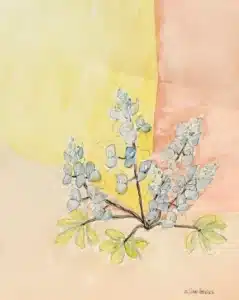
“Bluebonnets” by Nan Henke
Still by Megan Willome
(from The Joy of Poetry)
A clump of bluebonnets stands in the alley
long past Memorial Day. Usually they’re fried by Easter.
In the spring they grow
in green pastures,
beside busy highways.
Now they look tired, out of place,
like they didn’t get the notice that it’s time
to make room for the warm wildflowers.
Tomorrow is Independence Day and they’re still there
barely blue.
The Mexican hats, the wine cups cups, even
the fire wheels have faded.
Those stubborn bluebonnets hang on
like my mother
still thriving through cancer
after cancer
after cancer.
I had an opportunity to catch up with both Megan and Nan about the collaboration.
How long have you known each other? How did you meet?
Megan: I have written copy for the Texas Hill Country Art Guide for several years, which means I’ve gotten to know a lot of local artists, including Nan. We’ve known each other about five years, but not well until this collaboration.
Nan: I’m not sure what year Megan and I met. It was probably at least five or six years ago, but we never knew each other very well. Last fall we emailed back and forth in order to settle some question about the art guide and I noticed that her email signature included a reference to a newsletter. Just to be polite, I signed up for the newsletter, even though I had no interest in poetry. But I ended up enjoying her newsletter and her short, real-life, often funny poems.
How did the exhibition come to be?
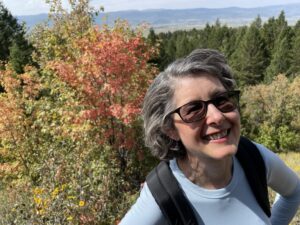
Megan Willome
Megan: Nan gets all the credit. She began reading my Poetry for Life Substack and reached out to me. Members of the Art Guild rotate to do a solo show, and her next opportunity was scheduled for April. She asked me if I’d be interested in doing a joint poetry and art thing, and I was thrilled to participate. I know Nan’s art by sight, and I knew we would be a good fit. We’re similar in our approach to our creative lives. I went out to her ranch, and she laid out dozens and dozens of paintings for me to look through. I grabbed the 50 or so that grabbed me. Some I knew would go with an existing poem. Some I wanted to write a poem about. Some were so Fredericksburg-y that we knew they had to be in the show. I wrote for about a month, then sent Nan everything. From there we paired paintings and poems. We were always in sync on this project. We laid everything out on the floor, and with only a few caveats, let her decide what would go up, framed, and what would remain unframed but matted, in the basket. Nan wanted the two paintings that go with my laundry poem, “The cure for writer’s block,” to be the center, and there were two large paintings that went on the sides. One went with my poem “Uncloudy Day,” and the other was a new one I wrote because I liked her sky.
Nan: For my solo art show set for April, I wanted to do something out of the ordinary – something that would emphasize that every painting has a story. Because of her appealing newsletter, Megan sprang to mind as a possible collaborator. Luckily, she did not hold it against me that I prefaced my invitation by stating, “I do not like poetry.” As I ended up writing to my followers later, she just smiled that Mona Lisa smile and her eyes communicated that I probably hadn’t met poetry yet.
I’m interested in the “local” idea. You describe the show as one by a local poet and a local artist. Can you speak to what this might mean in your writing and art?
Nan: Both of us exercise our crafts on any topic that strikes us, but mostly things from our everyday lives like laundry, wildflowers or current events on the local scene. An example is the recent closing of Dooley’s 5-10-25-cent store, a beloved local icon that has been in Fredericksburg for 99 years. When Megan saw my painting of Dooley’s, she chose to create a poem to go with it. That was one of the poem/painting combinations that sold on opening night to a local resident.
How much work went into the organizing and staging of the exhibition?
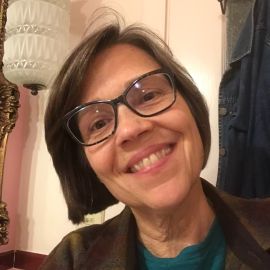
Nan Henke
Megan: She approached me in early January, and I picked the paintings near the end of the month. So, we’ve basically worked on it all spring. Nan said it was a different experience, having her own show and not getting to choose most of the artwork.
Nan: Putting an art show together and promoting it well always takes 2 to 3 months of hard work. We started with Megan reviewing my art inventory and choosing a stack of paintings that she either knew would match an existing poem or that might inspire a poem. I started by reading her books and choosing poems that I wanted to create paintings to match. My clothes washer and dryer paintings titled “But What Is the Cure for Laundry?” are a good example. They illustrate her poem “The Cure for Writer’s Block.” Then we did the Great Double-Dare where we got out of our comfort zones: Megan had to paint and I had to write a poem about her painting! At one point I had poems and paintings all over my living room floor. We finally narrowed it down to a list of about 40 pairs and brought in a friend who is skilled at hanging art shows. We told her not to overcrowd the space, that we had purposely given her too many paintings and poems. She chose about half, which she thought made the best visual presentation. The rest were unframed and placed for sale at the show as matted poem and painting pairs. Never in my life have I had so little control over what pieces go in a show; I think it was good for me.
Can you speak to the connections between art and poetry? Both are artistic disciplines, but one is written and one is drawn or painted. How do they intersect?
Megan: For me, I found having this task to write about art very freeing. I didn’t put any expectations on myself, just played. Of course, there’s a long and glorious tradition of ekphrastic poetry, but I didn’t feel like I was doing anything that lofty. I went with my first instinct and let ‘er rip. Nan will probably tell you about our poetry/art dare—because she mentioned it to everyone who came to see the show. It was my first time to pick up a paintbrush since elementary school. Art is not my medium, but Nan is an excellent teacher (she teaches watercolor classes), and I had fun. The painting gave me a chance to express something I don’t yet have words for. Maybe I never will. I’m happy that her poem now accompanies it, giving it new meaning.
Nan: I’m continually surprised at how much poets and painters have in common. The bottom line, I think, is that we pay attention to ordinary life more than most folks do, because we know that we are going to want to use our craft to describe and share it. By the way, Megan says that she will not be painting anything any time soon. I, on the other hand, have started not only reading but also writing poetry. Not particularly good poetry, but it is a start.
Related:
Crow Stories: Rainbow Crow by Megan Willome and Hasani Browne
A Christmas Carol by Charles Dickens – and Megan Willome
Photo by Mike Norton, Creative Commons, via Flickr. Post by Glynn Young.
How to Read a Poem uses images like the mouse, the hive, the switch (from the Billy Collins poem)—to guide readers into new ways of understanding poems. Anthology included.
“I require all our incoming poetry students—in the MFA I direct—to buy and read this book.”
—Jeanetta Calhoun Mish
- Poets and Poems: Beth Copeland and “I Ask the Mountain to Heal My Heart” - July 10, 2025
- A.E. Stallings: the Parthenon Marbles, Poets, and Artists - July 8, 2025
- Poets and Fables: Steven Flint and “The Sun and the Boy” - July 3, 2025
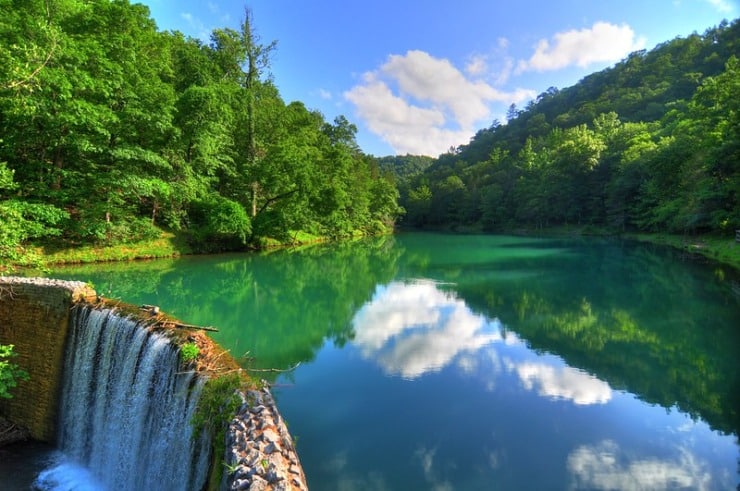
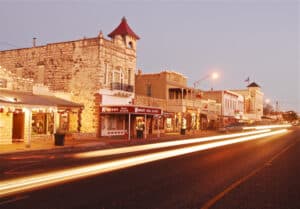

Sandra Heska King says
“Just to be polite, I signed up for the newsletter”
Who knows what can come of just being polite.
I love this so much. I wish I could take a field trip to Fredericksburg.